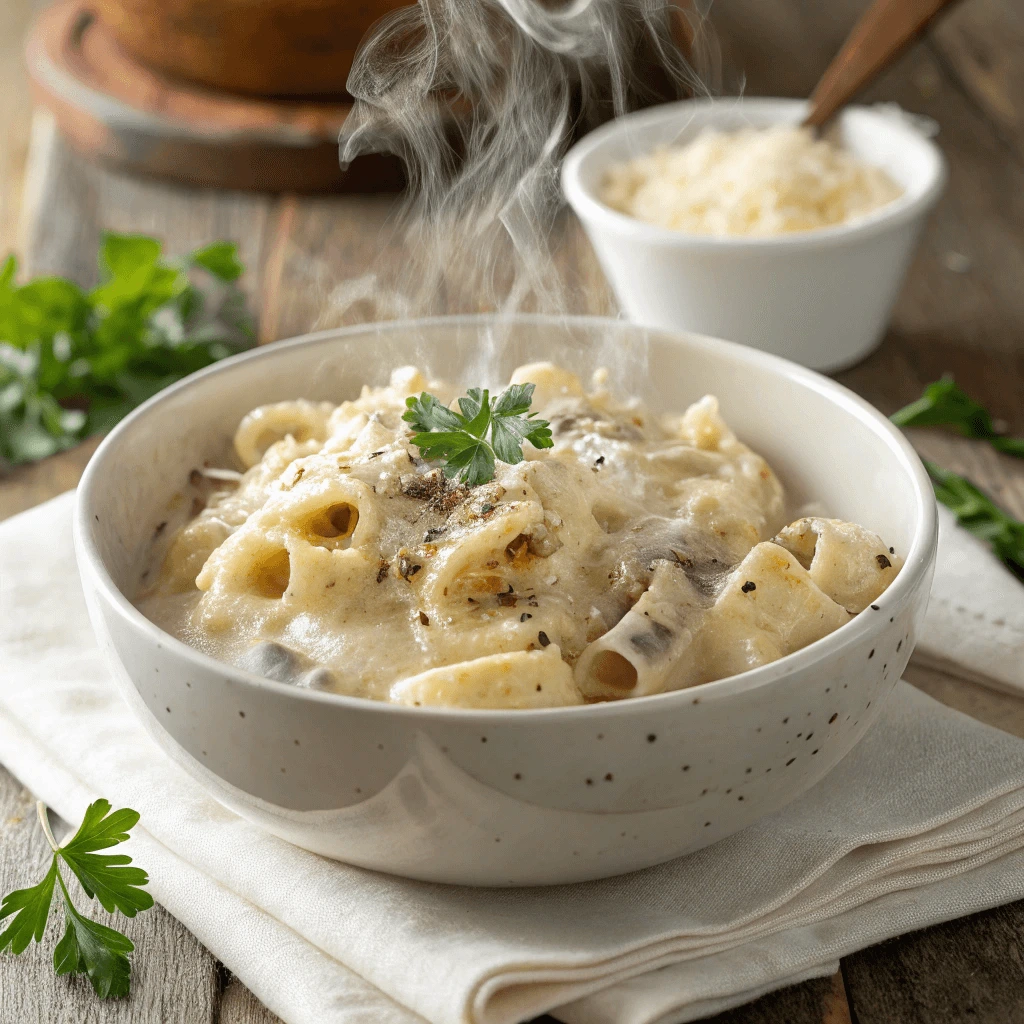lumache pasta, with its unique shell shape and ridged texture, offers a delightful experience for any pasta lover. When paired with the right sauce, Lumache truly shines, its curves and ridges allowing the sauce to cling perfectly to each bite. Whether you’re cooking for a special occasion or enjoying a comforting weeknight meal, choosing the ideal sauce can elevate your dish to new heights. In this post, we’ll explore the five best sauces to pair with Lumache pasta—each one complementing its texture and flavor in a unique way. From the richness of creamy Alfredo to the fresh and fragrant notes of pesto, these sauces are sure to bring out the best in this versatile pasta shape.
Classic Marinara – A Time-Tested Favorite
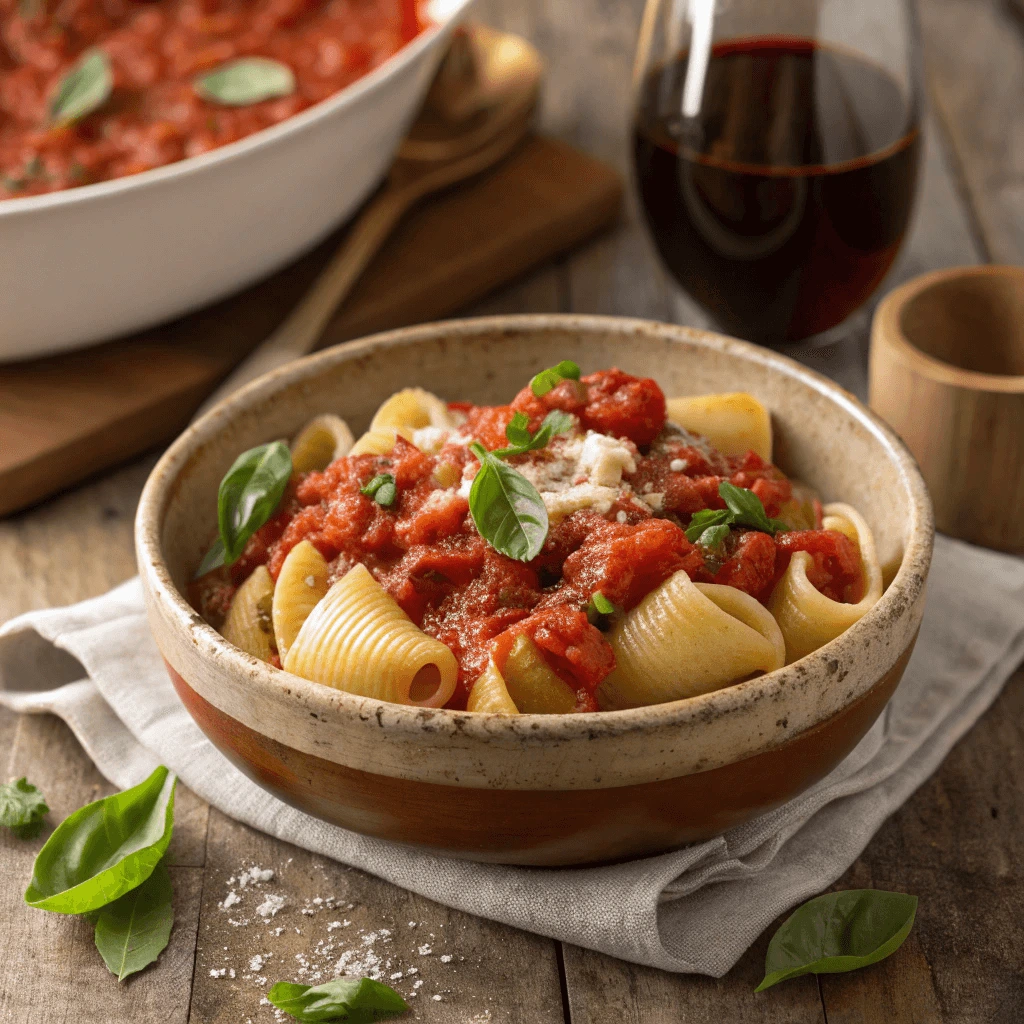
Why Marinara Works with Lumache
Lumache’s Shape Enhances Sauce Retention
Lumache pasta, shaped like a snail shell with a ridged exterior and open center, naturally captures chunky sauces. Each bite delivers a balanced mix of pasta and marinara, making the eating experience more flavorful. The curves and ridges aren’t just decorative—they hold onto bits of tomato, garlic, and herbs that might slide off smoother noodles like spaghetti or linguine.
Texture Harmony Between Pasta and Sauce
The soft yet slightly firm bite of al dente lumache pairs beautifully with marinara’s chunky texture. Instead of slipping off, the sauce clings to the pasta, creating a rich and hearty mouthfeel. When you stir lumache into marinara, the sauce coats it evenly, resulting in better distribution across the dish.
Flavor Balance That Highlights Simplicity
Marinara is known for its simplicity—ripe tomatoes, garlic, onions, and olive oil come together to create bold flavor without needing complex ingredients. Lumache doesn’t overpower these subtle notes. Instead, it complements them, letting the fresh ingredients shine through while still offering structure and substance to the dish.
Perfect for Both Fresh and Jarred Marinara
Whether you use a homemade tomato sauce or a high-quality store-bought jar, lumache pasta can handle it. If your marinara contains chunks of tomatoes or vegetables, the pasta traps those pieces perfectly. If it’s smooth, it still adheres well to the pasta’s surface.
Best Ingredients for a Homemade Marinara
A rich and flavorful marinara sauce starts with fresh, high-quality ingredients. Making your own sauce allows you to control the flavor, texture, and nutritional value. Here’s what to include for the perfect homemade marinara that pairs beautifully with lumache pasta.
Ripe Tomatoes: The Foundation of Flavor
Use ripe, juicy tomatoes for the best results. San Marzano tomatoes are ideal thanks to their natural sweetness and low acidity. If fresh tomatoes aren’t available, choose whole peeled canned tomatoes labeled San Marzano. You can also blanch and peel Roma or plum tomatoes to create a vibrant, fresh base.
Aromatics: Garlic and Onion
Sauté chopped onions in olive oil until soft and translucent. Then add minced garlic for a flavorful kick. Adding the garlic after the onions ensures it doesn’t burn, preserving its rich taste. This step lays the groundwork for a savory and layered sauce.
Herbs and Seasonings: Elevate the Taste
Fresh basil brings sweetness and a light herbal note, while oregano adds earthiness. A pinch of red pepper flakes gives the sauce a subtle heat. Finish with salt and freshly ground black pepper to highlight the flavors without overpowering them.
Olive Oil: The Essential Base
Choose high-quality extra virgin olive oil to start your sauce. It not only helps cook the aromatics but also brings a smooth, slightly fruity finish that enhances the entire dish. Avoid using neutral oils, which won’t provide the same flavor depth.
Optional Add-Ins for Richness
To add depth, stir in a spoonful of tomato paste or a splash of vegetable broth. These ingredients thicken the sauce naturally and intensify the tomato flavor without adding artificial ingredients or sugar.
Serving Suggestions
Pairing your lumache pasta with the right sides and garnishes can enhance the entire meal. Here are a few simple yet effective serving ideas:
Sprinkle Freshly Grated Parmesan
Grate fresh Parmesan cheese over the hot pasta just before serving. The cheese melts beautifully into the sauce, adding a rich, savory note. Always choose a block of Parmesan and grate it yourself for the best flavor and texture.
Serve with Garlic Bread or Rolls
Warm garlic bread is a classic companion to pasta dishes. Toast slices with olive oil, garlic, and herbs until golden and crisp. Crusty Italian rolls or whole-grain bread also work well to soak up the remaining sauce.
Add a Light Side Salad
Balance the richness of the pasta with a fresh salad. A simple mix of greens like arugula or spinach dressed in lemon juice and olive oil adds brightness and contrast to the meal.
These thoughtful touches can turn a regular pasta dinner into a comforting and well-rounded experience.
Creamy Alfredo – Rich and Indulgent
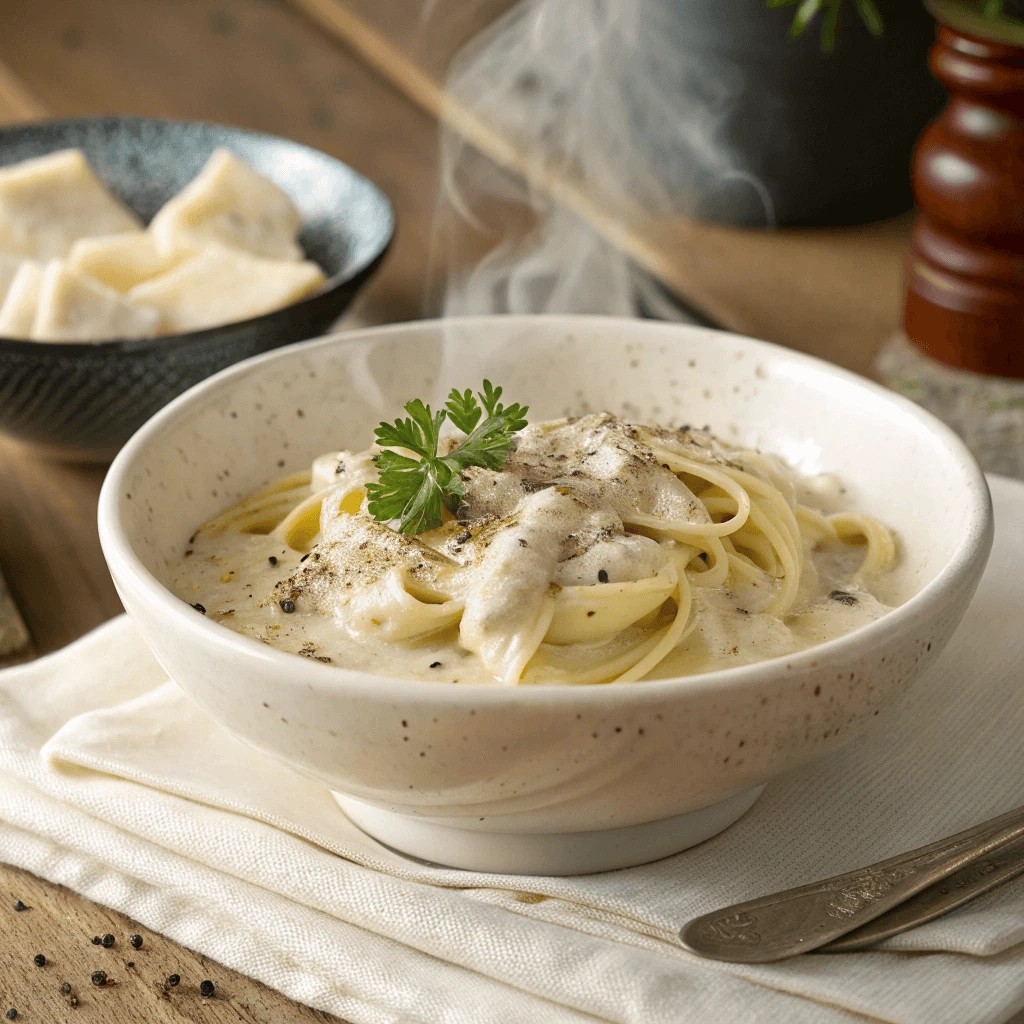
Ideal Texture for Lumache Pasta
Achieving the perfect texture is key to enjoying lumache pasta at its best. Understanding how to cook it properly ensures every bite delivers that satisfying chew and sauce-holding capability.
Al Dente: The Goal for Lumache
The ideal texture for lumache pasta is al dente, which means “to the tooth” in Italian. This means the pasta should be tender but still firm when bitten. Cooking lumache al dente prevents it from becoming mushy and helps it hold its shape well, especially important because of its unique shell shape.
Testing for Doneness
To check if your lumache is al dente, start tasting it a minute or two before the package’s recommended cooking time ends. The pasta should feel slightly resistant when bitten but not hard or chalky. Avoid overcooking, as it can make the shells collapse and lose their ability to trap sauce.
Why Texture Matters
Lumache’s ridged, curved shape is designed to catch sauces and ingredients. When cooked to the right texture, each shell can scoop up more sauce and fillings, enhancing the flavor in every bite. Overcooked pasta tends to slide around and doesn’t cling to sauces as effectively.
Simple Alfredo Ingredients
Creating a delicious Alfredo sauce requires just a few simple ingredients. Using fresh, quality components can elevate the flavor and make your lumache pasta truly shine.
Fresh Cream and Butter
The foundation of any Alfredo sauce starts with fresh heavy cream and butter. These two ingredients blend smoothly to create the sauce’s signature creamy texture. Use unsalted butter so you can control the seasoning better.
Parmesan Cheese for Richness
Freshly grated Parmesan cheese adds richness and depth to Alfredo sauce. Its sharp, nutty flavor balances the creaminess while giving the sauce that classic Italian taste. Avoid pre-grated cheese because it often contains anti-caking agents that can affect the sauce’s texture.
Garlic for Aromatic Flavor
Garlic brings a subtle, aromatic punch to Alfredo sauce. Mince it finely and gently sauté it in butter to release its fragrance without overpowering the sauce. This step enhances the overall flavor profile.
Salt and Pepper to Taste
Season the sauce with salt and freshly ground black pepper. These simple seasonings help highlight the other ingredients and bring the sauce together. Add them gradually and taste as you go to achieve the perfect balance.
When to Serve It
Knowing the best occasions to serve lumache pasta with Alfredo sauce can help you impress guests and enjoy this dish at its peak.
Perfect for Weeknight Dinners
Lumache pasta with Alfredo sauce makes a fantastic choice for quick and satisfying weeknight meals. Its creamy texture and rich flavor provide comfort after a busy day. Since the sauce comes together quickly with simple ingredients, you can whip up a delicious dinner without spending hours in the kitchen.
Ideal for Casual Gatherings
This dish works wonderfully for casual get-togethers with family or friends. The combination of tender pasta and creamy sauce feels indulgent yet approachable. Serve it alongside a fresh salad or garlic bread to complete the meal. Its crowd-pleasing nature makes it a popular pick for potlucks or informal dinners.
Great for Special Occasions
You can also elevate lumache pasta with Alfredo sauce for special occasions. Pair it with grilled vegetables or a light protein like chicken or seafood to create an elegant plate. The creamy sauce adds a touch of luxury that fits well with celebrations or dinner parties.
Pesto Genovese – Fresh and Herbaceous
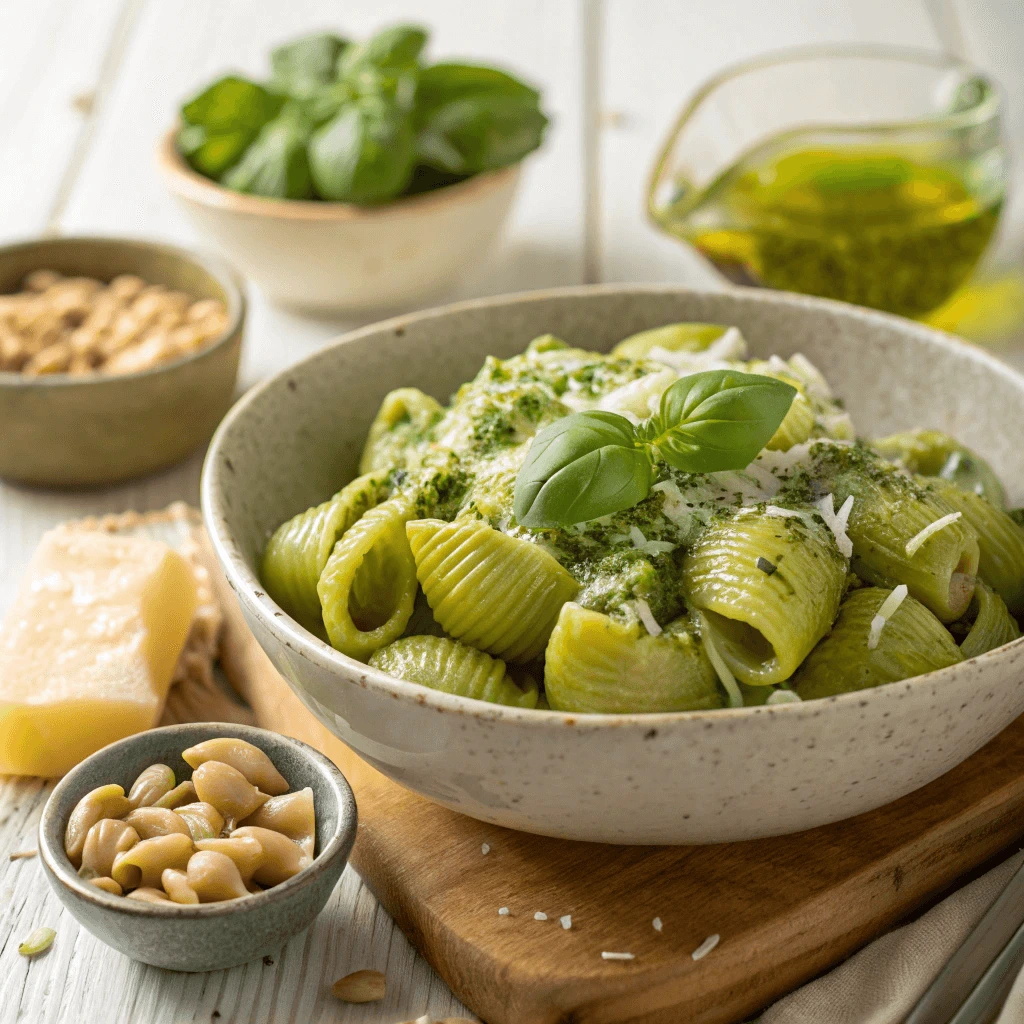
Basil and Lumache: A Perfect Match
Basil enhances lumache pasta dishes in many delightful ways. This aromatic herb complements the pasta’s unique shape and texture, creating a harmonious flavor experience.
The Freshness Basil Brings
Basil adds a fresh, slightly sweet, and peppery note that lifts the entire dish. When you toss lumache pasta with basil, the herb’s vibrant flavor cuts through creamy or rich sauces, balancing the overall taste. Fresh basil leaves release essential oils that infuse each bite with a fragrant aroma.
How Lumache Holds the Flavor
The shell-like shape of lumache captures sauces and herbs exceptionally well. Its curved surface creates little pockets that trap bits of basil, making every mouthful flavorful. This pasta shape’s texture allows it to cling to ingredients more effectively than smoother pasta varieties.
Ways to Incorporate Basil with Lumache
You can use basil in several ways to highlight its flavor. Add fresh chopped basil at the end of cooking to preserve its brightness. Alternatively, blend basil into a pesto sauce to coat the lumache pasta evenly. Another option is to garnish the dish with whole basil leaves for a visually appealing touch and an extra burst of aroma.
Tips for Making Fresh Pesto
Making fresh pesto at home brings vibrant flavor and freshness to your lumache pasta dishes. Follow these tips to create a pesto that bursts with aroma and tastes just right.
Choose Fresh, High-Quality Ingredients
Start with fresh basil leaves that have a bright green color and no signs of wilting or browning. Fresh garlic, good-quality extra virgin olive oil, pine nuts, and freshly grated Parmesan cheese complete the classic pesto base. Using fresh and high-quality ingredients ensures your pesto will have the best flavor and texture.
Toast the Pine Nuts Lightly
Toasting pine nuts before adding them to your pesto enhances their nutty flavor. Heat a dry pan over medium heat and stir the pine nuts frequently until they turn golden brown. Be careful not to burn them, as burnt pine nuts can make the pesto taste bitter.
Use a Food Processor or Mortar and Pestle
You can use a food processor for convenience, but a mortar and pestle offer a more traditional method that helps release the essential oils in the basil leaves and garlic. Either way, combine the basil, garlic, toasted pine nuts, and Parmesan, then slowly drizzle in olive oil while blending until the mixture reaches a smooth but slightly textured consistency.
Season and Adjust
After blending, taste your pesto and add salt or more cheese as needed. Fresh lemon juice adds a bright note and helps preserve the vibrant green color of the basil. Avoid over-blending to maintain a pleasant texture that will cling well to lumache pasta.
Flavor Variations
Exploring different flavor variations can take your lumache pasta dishes to the next level. Experimenting with various ingredients allows you to customize your sauce and keep your meals exciting. Here are some popular flavor twists you can try:
Nutty and Earthy Twists
Swap out pine nuts for walnuts or almonds in your pesto to introduce a richer, earthier flavor. Toasting these nuts lightly before adding them enhances their aroma and brings out deeper notes. Adding a handful of fresh spinach or kale to the pesto mixture also adds a subtle earthiness and boosts the nutritional value.
Zesty and Citrusy Options
Incorporate lemon zest or a squeeze of fresh lemon juice into your sauce to brighten the flavors. Lemon pairs wonderfully with basil and garlic, giving your pesto a refreshing twist. For an extra zing, try adding a small amount of orange zest or a splash of white balsamic vinegar, which balances the richness with a mild acidity.
Spicy Variations
Add a pinch of crushed red pepper flakes or a fresh chili pepper to your sauce to introduce some heat. The spicy kick contrasts beautifully with the creamy texture of the pesto and complements the shape of lumache pasta, which holds the sauce well. Adjust the spice level to suit your taste, ensuring it enhances but doesn’t overpower the dish.
Herb and Cheese Alternatives
Try mixing fresh herbs such as parsley, cilantro, or mint into your pesto for a different herbal profile. You can also experiment with different cheeses like Pecorino Romano or Asiago instead of Parmesan. These cheeses add a sharper or more robust flavor, giving your lumache pasta a unique twist.
Garlic and Olive Oil – Simple and Elegant
Why Minimal Ingredients Shine
When it comes to pairing sauces with lumache pasta, less often truly means more. Minimal ingredients allow each component to stand out, delivering a meal that feels both comforting and refined.
Letting the Pasta Speak
Lumache pasta has a unique shape and texture that deserves to be noticed. When you use minimal ingredients, you highlight the pasta’s natural ability to trap sauce inside its curves. Instead of masking its qualities with heavy or overly complex sauces, a simple combination of garlic, olive oil, and herbs allows the pasta to be the star of the dish.
Highlighting Quality Over Quantity
Using fewer ingredients means each one must be high quality. A well-pressed extra virgin olive oil, freshly grated Parmesan, or ripe tomatoes can elevate a dish with minimal effort. Freshness and flavor come through more clearly when they aren’t competing with a long list of add-ins. This focus on quality creates a dish that tastes rich and satisfying, even with a short ingredient list.
Balanced and Digestible Meals
Minimal ingredient recipes often feel lighter and easier to digest. When you keep it simple, your meal stays balanced without overwhelming your palate. This approach also helps when serving guests or picky eaters, as the clean flavors appeal to a wide range of preferences.
Easy to Prepare, Hard to Forget
Another benefit of minimal ingredients is simplicity in preparation. With just a few staples, you can create a memorable meal in minutes. This not only saves time but also reduces waste and stress in the kitchen.
In essence, minimalism in cooking with lumache pasta isn’t about cutting corners—it’s about honoring ingredients and letting their natural flavors shine.
Cooking Technique for Best Results
To bring out the best in lumache pasta, you need more than just boiling water—technique matters. Lumache’s curved shape and ridged surface are designed to hold sauce, but only if it’s cooked properly.
Start with salted water. Use a large pot with plenty of water and salt it generously—this seasons the pasta from the inside. A tablespoon of salt per 4–5 cups of water is a good starting point.
Cook until al dente. Follow the package instructions, but start testing the pasta 1–2 minutes before the recommended time. Al dente pasta has a slight bite and won’t get mushy when tossed with sauce.
Finish in the sauce. For the best flavor and texture, drain the pasta just before it’s done and add it directly to your simmering sauce. Stir gently for another minute or two, allowing the pasta to absorb flavor and starch to thicken the sauce naturally.
Serve immediately. Let the dish rest briefly, then top it with cheese, herbs, or a drizzle of olive oil for a final flavor boost. Cooking lumache this way enhances its natural texture and ensures every bite is packed with flavor.
Enhancing with Herbs or Chili Flakes
Fresh herbs and chili flakes may seem like simple additions, but they can completely elevate your lumache pasta dish. These small touches introduce complexity and balance, transforming a good pasta meal into a great one.
Fresh Herbs for Aroma and Brightness
Herbs like basil, parsley, oregano, and thyme add bursts of freshness that complement creamy, tomato-based, or olive oil sauces. Basil pairs especially well with pesto or marinara, while chopped parsley adds color and a clean, peppery finish to richer sauces like Alfredo or mushroom cream. Add delicate herbs at the end of cooking to preserve their aroma and flavor.
Chili Flakes for Gentle Heat
Red pepper flakes offer just the right amount of spice without overwhelming the palate. A small pinch added to oil at the beginning infuses warmth throughout the sauce. Alternatively, sprinkle them on just before serving for a subtle kick that builds with each bite. Chili flakes shine particularly in garlic olive oil sauces or tomato-based recipes.
Balance Is Key
The key to using herbs and spices effectively is balance. Don’t overdo it—let the pasta and sauce remain the star. A light hand with seasoning allows the depth of the main ingredients to shine through while adding a personalized touch to the dish.
Whether you’re looking to enhance flavor, add color, or introduce a bit of heat, herbs and chili flakes offer a quick, affordable way to customize your lumache pasta and make it unforgettable.
Savory Mushroom Cream Sauce – Earthy and Hearty
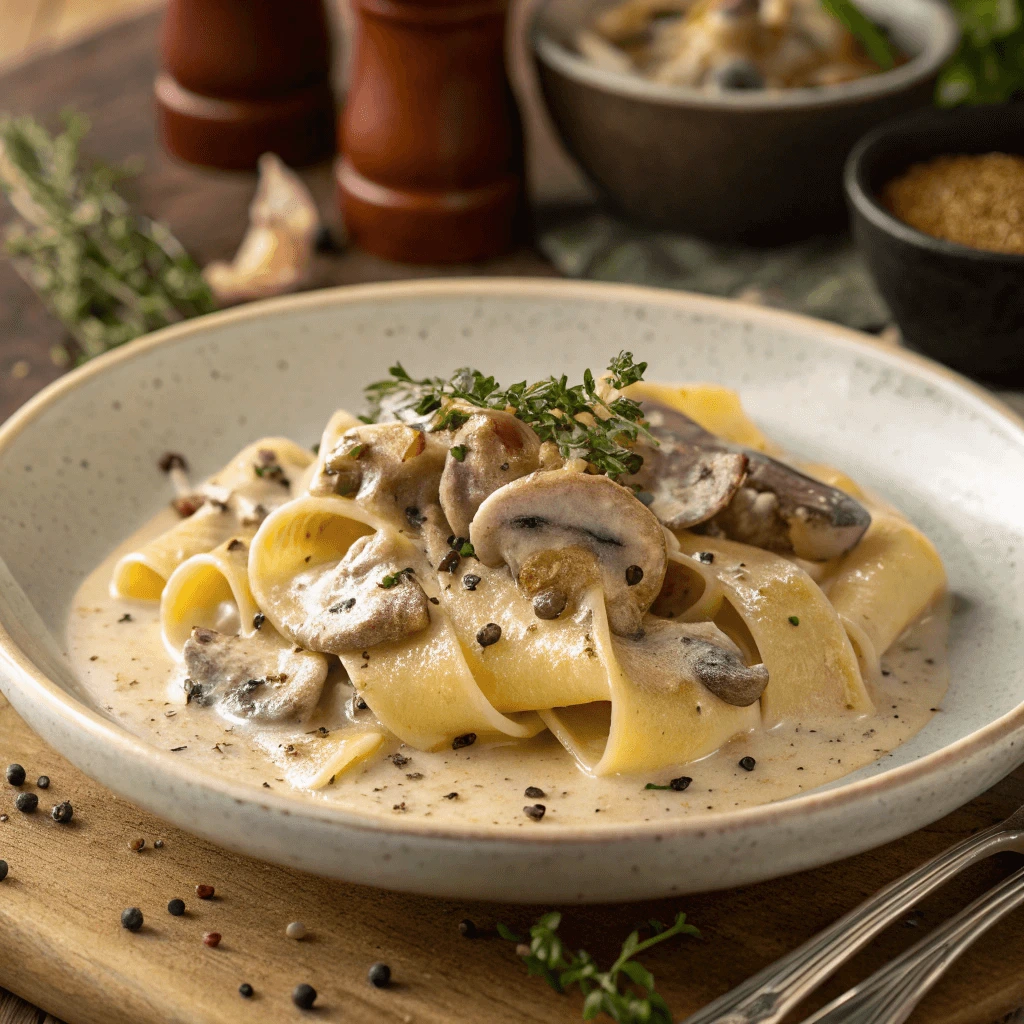
Flavor Depth from Mushrooms
Mushrooms play a powerful role in adding rich, earthy depth to any pasta dish, and they pair beautifully with lumache’s ridged shape and sauce-catching curves.
Umami-Rich Ingredients
Mushrooms bring umami — the savory, mouthwatering “fifth taste” — to the forefront. Varieties like cremini, shiitake, and portobello intensify the flavor profile, especially when sautéed until golden brown. This browning process, known as the Maillard reaction, unlocks complex layers of flavor that make the dish more satisfying and full-bodied.
Complementing Creamy and Tomato Sauces
When combined with cream, mushrooms create a velvety, savory sauce that clings to every nook of lumache pasta. In tomato-based sauces, they add contrast and meatiness, even in vegetarian recipes. They also blend seamlessly with garlic, onions, herbs, and even a splash of broth for added depth.
Cooking Tips for Maximum Flavor
To make the most of your mushrooms, cook them in a wide pan with minimal stirring. Allow them to brown undisturbed for a few minutes on each side before adding other ingredients. Avoid overcrowding the pan, as too much moisture can cause them to steam rather than sauté.
Whether you’re crafting a creamy mushroom sauce or folding them into a red sauce for added body, mushrooms provide a hearty, flavorful base that enhances the overall dish. Their earthy richness complements the smooth, soft bite of lumache pasta, creating a comforting and well-rounded meal.
Cream and Broth Combo
Combining cream and broth is a smart and flavorful way to create a rich yet balanced sauce for lumache pasta. This duo works well in many recipes because it offers both body and depth without overwhelming the other ingredients.
Balancing Richness and Lightness
Heavy cream alone can sometimes feel too thick or indulgent, but adding broth lightens the texture while maintaining a velvety feel. The cream brings richness, while the broth — whether it’s vegetable, chicken, or mushroom — adds savory notes that deepen the overall flavor. This balance creates a sauce that clings to lumache perfectly without being too heavy.
Layering Flavors with Simmering
Start by sautéing garlic or onions in a bit of olive oil or butter. Then, pour in the broth and let it simmer for a few minutes to build a base of flavor. Adding the cream afterward allows it to absorb the richness of the aromatics and the umami in the broth. Simmer gently until the sauce thickens slightly. Avoid boiling, as this may cause the cream to separate.
Enhancements and Variations
You can customize this combo by stirring in grated Parmesan, fresh herbs like thyme or parsley, or even a pinch of nutmeg for a warm undertone. For extra depth, try deglazing the pan with a splash of lemon juice or white wine (if you use alcohol), but even without wine, the broth-cream pairing stands strong on its own.
This cream-and-broth blend creates a sauce that wraps around lumache pasta beautifully, enhancing each bite with flavor and silky texture. It’s a versatile base that adapts to many ingredients while keeping your pasta dish smooth, savory, and satisfying.
Best Occasions to Serve
Lumache pasta’s unique shape and hearty texture make it a versatile dish for many occasions. Whether you’re preparing a simple weeknight dinner or hosting a festive gathering, this pasta can adapt beautifully with the right sauce and presentation.
Casual Weeknight Dinners
Busy evenings call for meals that are comforting and easy to make. Lumache pasta works perfectly for quick dinners because it pairs well with simple sauces like marinara, pesto, or a light Alfredo. You can cook the pasta, toss it with a ready-made or homemade sauce, and serve a satisfying meal in under 30 minutes. Families especially appreciate its ability to hold sauces well, ensuring each bite is flavorful.
Special Family Gatherings
When you’re bringing loved ones together for birthdays, holidays, or Sunday dinners, lumache pasta makes an excellent centerpiece. Try rich and creamy sauces or a baked lumache pasta dish loaded with cheese and vegetables. Because its shape traps ingredients so well, it gives every mouthful a delightful combination of textures and flavors. It’s a crowd-pleaser that looks as good as it tastes.
Dinner Parties and Entertaining
Hosting friends or guests? Lumache pasta offers an elegant yet comforting choice for the main course. Present it with a gourmet touch—use fresh herbs, high-quality cheeses, and artisan sauces to elevate the dish. A truffle cream sauce or mushroom cream blend can transform lumache into a luxurious plate that impresses without being overly complicated to prepare.
Conclusion
Lumache pasta pairs beautifully with a variety of sauces, making it a must-have in any kitchen. From creamy Alfredo to rich mushroom blends, the best sauces for lumache pasta truly highlight its ridged, shell-like shape. This pasta captures flavor in every bite, no matter the season. Don’t be afraid to try new combinations and discover your own best sauces for lumache pasta. Whether you’re cooking for yourself or entertaining guests, lumache shines in every dish. Explore, taste, and enjoy the best sauces for lumache pasta again and again.
